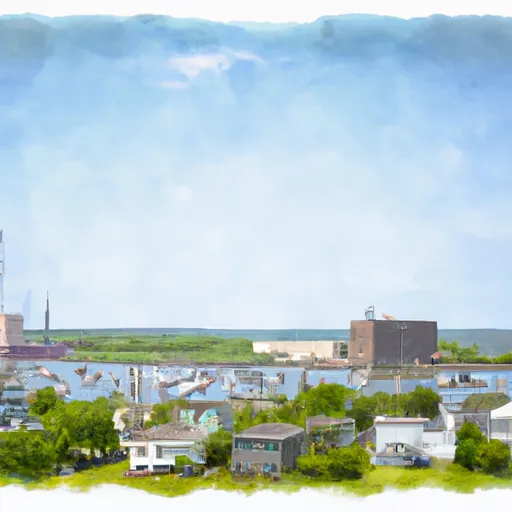-
 Snoflo Premium
Snoflo Premium
Get unlimited access to all our content
With no Ad interruptions! - Start Your Free Trial Login with existing account
Port-Penn
Eden Index
Climate
9.7
•
Recreation
4.2
•
Community
1.4
•
Safeguard
5.7/10

Port Penn is a charming town located in New Castle County, Delaware, with a population of about 100 residents. The town boasts a unique climate, characterized by mild winters and hot summers, typical of the Mid-Atlantic region. Summers in Port Penn often see temperatures ranging from the mid-80s to low 90s°F, while winters average in the high 30s to low 40s°F.
Situated at the convergence of the Delaware River and the Chesapeake Bay, Port Penn offers a rich hydrology that attracts outdoor enthusiasts. The town provides excellent opportunities for boating, fishing, and crabbing, thanks to its proximity to these water bodies. The Delaware River is particularly renowned for its diverse fish species, including striped bass, shad, and catfish.
Outdoor recreation opportunities in Port Penn extend beyond the water. The town is surrounded by picturesque landscapes, making it a great destination for hiking, bird watching, and nature photography. The Port Penn Interpretive Center provides educational programs and guided walks, allowing visitors to explore the unique wetland habitats and learn about the local flora and fauna.
Overall, Port Penn offers a delightful combination of a favorable climate, diverse hydrology, and abundant outdoor recreation opportunities, making it an attractive destination for nature lovers.
What is the Eden Index?
The Snoflo Eden Index serves as a comprehensive rating system for regions, evaluating their desirability through a holistic assessment of climate health, outdoor recreation opportunities, and natural disaster risk, acknowledging the profound impact of these factors on livability and well-being.
Climate Health Indicator (CHI): 9.7
Port-Penn receives approximately
1115mm of rain per year,
with humidity levels near 78%
and air temperatures averaging around
13°C.
Port-Penn has a plant hardyness factor of
7, meaning
plants and agriculture in this region tend to thrive during the non-winter months.
By considering the ideal temperature range, reliable water supplies, clean air, and stable seasonal rain or snowpacks, the Climate Health Indicator (CHI) underscores the significance of a healthy climate as the foundation for quality living.
A healthy climate is paramount for ensuring a high quality of life and livability in a region, fostering both physical well-being and environmental harmony. This can be characterized by ideal temperatures, reliable access to water supplies, clean air, and consistent seasonal rain or snowpacks.
Weather Forecast
Streamflow Conditions
Lower Delaware
Area Rivers
Lower Delaware
Snowpack Depths
Lower Delaware
Reservoir Storage Capacity
Lower Delaware
Groundwater Levels
Recreational Opportunity Index (ROI): 4.2
The Recreational Opportunity Index (ROI) recognizes the value of outdoor recreational options, such as parks, hiking trails, camping sites, and fishing spots, while acknowledging that climate plays a pivotal role in ensuring the comfort and consistency of these experiences.
Access to outdoor recreational opportunities, encompassing activities such as parks, hiking, camping, and fishing, is crucial for overall well-being, and the climate plays a pivotal role in enabling and enhancing these experiences, ensuring that individuals can engage in nature-based activities comfortably and consistently.
Camping Areas
| Campground | Campsites | Reservations | Toilets | Showers | Elevation |
|---|---|---|---|---|---|
| Dover AFB Military | None | 25 ft |
Nearby Ski Areas
Catastrophe Safeguard Index (CSI):
The Catastrophe Safeguard Index (CSI) recognizes that natural disaster risk, encompassing floods, fires, hurricanes, and tornadoes, can drastically affect safety and the overall appeal of an area.
The level of natural disaster risk in a region significantly affects safety and the overall livability, with climate change amplifying these risks by potentially increasing the frequency and intensity of events like floods, fires, hurricanes, and tornadoes, thereby posing substantial challenges to community resilience and well-being.
Community Resilience Indicator (CRI): 1.4
The Community Resilience Indicator (CRI) recognizes that education, healthcare, and socioeconomics are crucial to the well-being of a region. The CRI acknowledges the profound impact of these elements on residents' overall quality of life. By evaluating educational resources, healthcare accessibility, and economic inclusivity, the index captures the essential aspects that contribute to a thriving community, fostering resident satisfaction, equity, and social cohesion.

